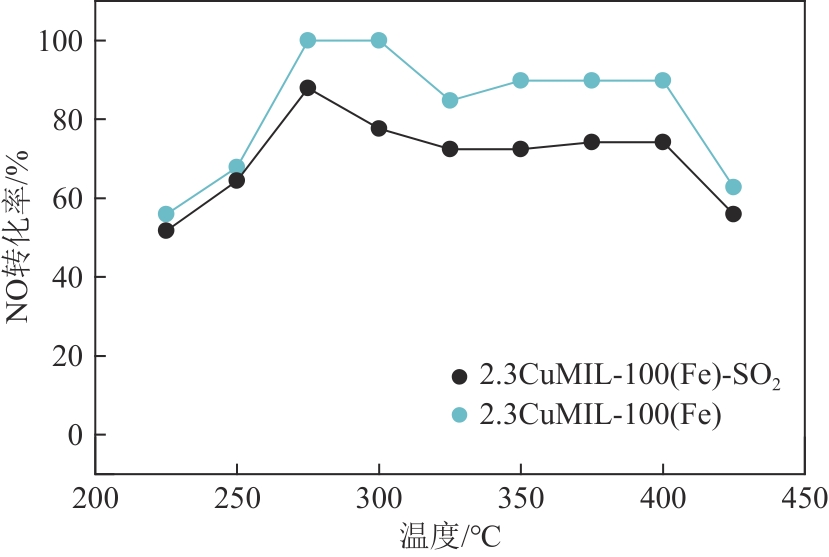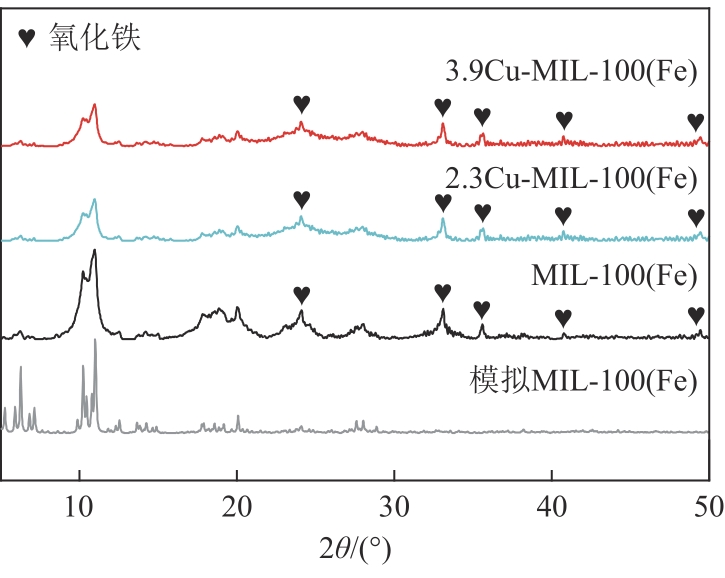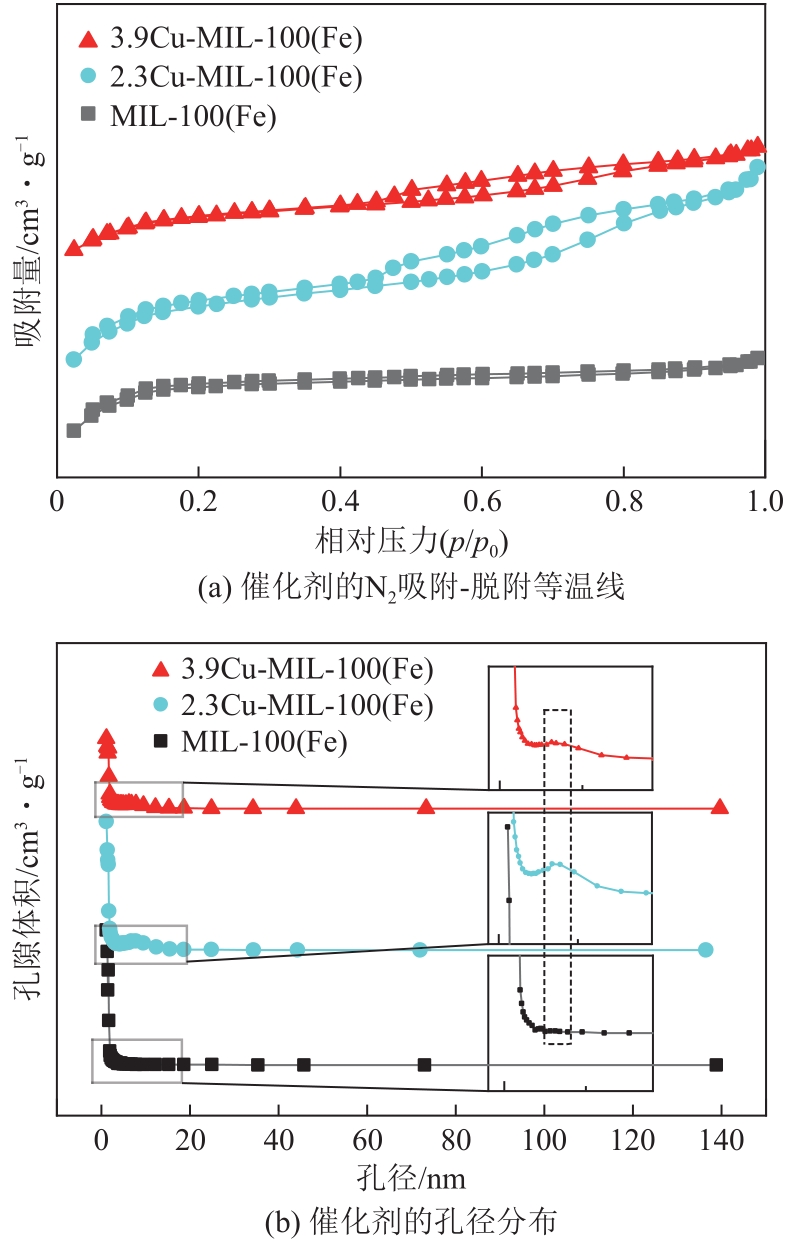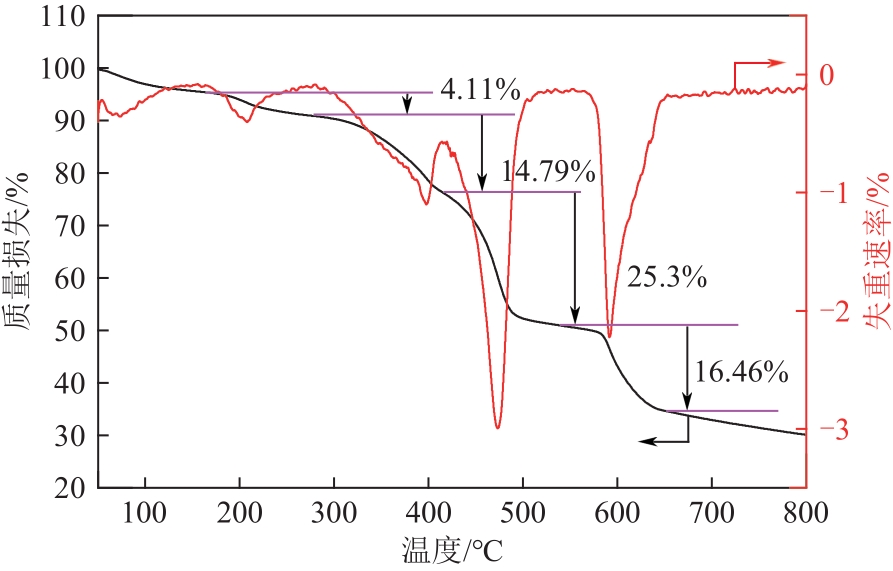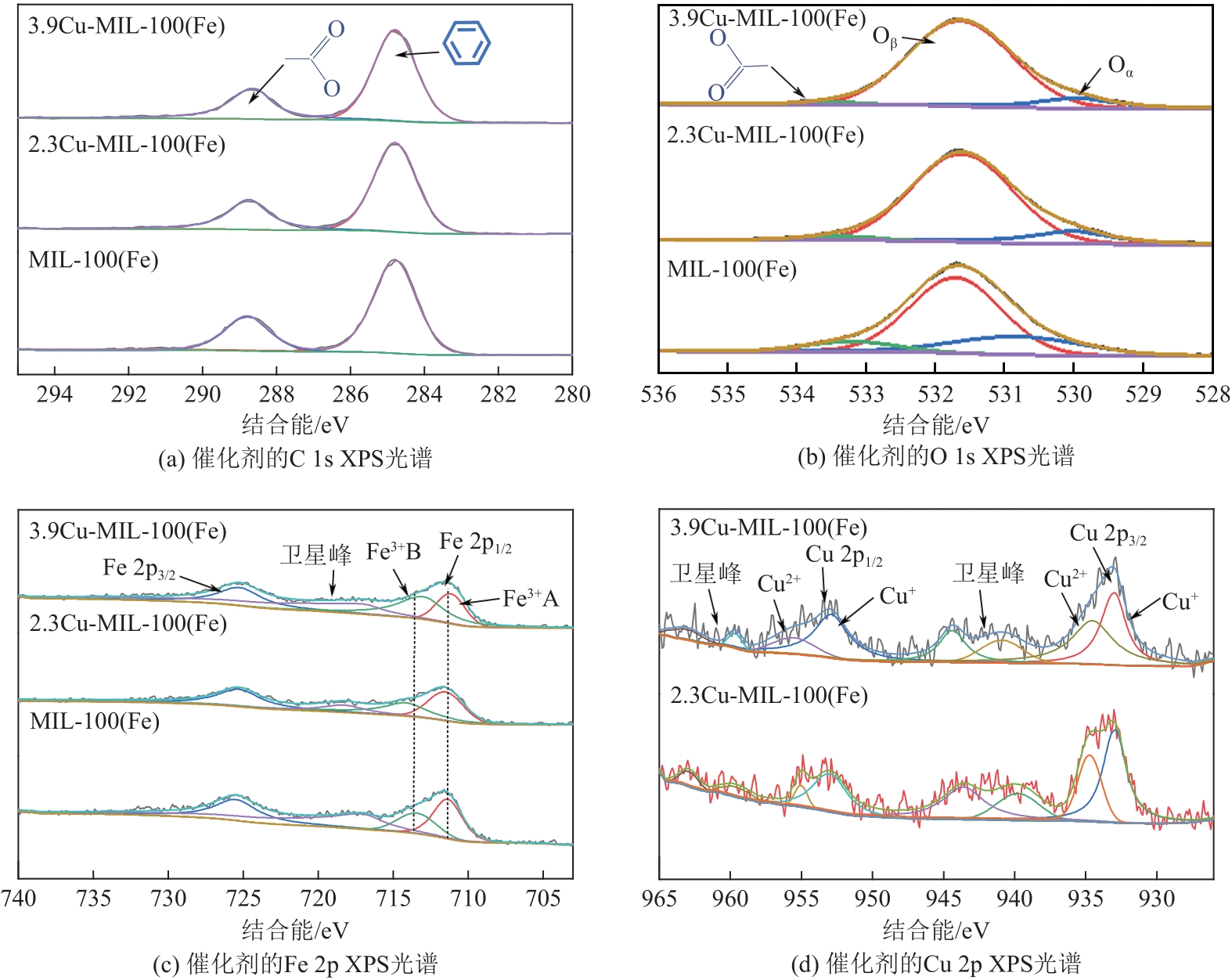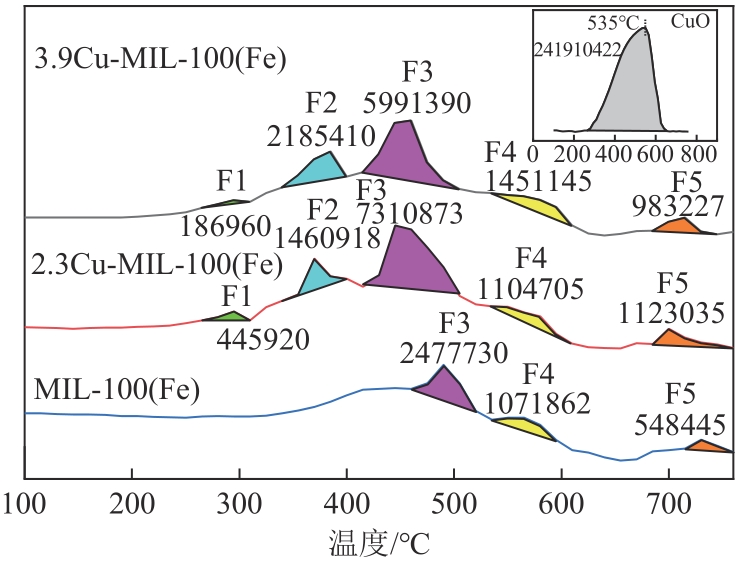化工进展 ›› 2024, Vol. 43 ›› Issue (9): 4951-4960.DOI: 10.16085/j.issn.1000-6613.2023-1340
• 工业催化 • 上一篇
Cu改性MIL-100(Fe)催化剂的SCR-C3H6脱硝特性
付维1( ), 宁淑英1, 蔡晨1, 陈佳音1, 周皞2, 苏亚欣1(
), 宁淑英1, 蔡晨1, 陈佳音1, 周皞2, 苏亚欣1( )
)
- 1.东华大学环境科学与工程学院,上海 201620
2.常州工程职业技术学院,江苏 常州 213164
-
收稿日期:2023-08-07修回日期:2023-12-20出版日期:2024-09-15发布日期:2024-09-30 -
通讯作者:苏亚欣 -
作者简介:付维(2000—),男,硕士研究生,研究方向为燃烧污染物控制。E-mail:fuwei2000117@163.com。 -
基金资助:国家自然科学基金(52276103)
SCR-C3H6 denitrification performance of Cu-modified MIL-100(Fe) catalysts
FU Wei1( ), NING Shuying1, CAI Chen1, CHEN Jiayin1, ZHOU Hao2, SU Yaxin1(
), NING Shuying1, CAI Chen1, CHEN Jiayin1, ZHOU Hao2, SU Yaxin1( )
)
- 1.School of Environmental Science and Engineering, Donghua University, Shanghai 201620, China
2.Changzhou Engineering Vocational and Technical College, Changzhou 213164, Jiangsu, China
-
Received:2023-08-07Revised:2023-12-20Online:2024-09-15Published:2024-09-30 -
Contact:SU Yaxin
摘要:
烃类化合物选择性催化还原氮氧化物(SCR-HC)是一种很有发展前景的脱硝技术。催化剂有效的氧化-还原能力是影响其活性的关键因素。利用水热法制备了新型有机金属骨架MIL-100(Fe),通过超声浸渍法合成不同Cu含量的mCu-MIL-100(Fe)催化剂,在固定床微反应器中对其催化C3H6选择性还原NO的特性进行了实验研究。结果表明Cu的引入使MIL-100(Fe)催化活性得到改善。2.3Cu-MIL-100(Fe)的NO转化率在275℃下可达到100%,275~400℃范围内可维持85%以上NO转化率及90%以上N2选择性,且具有较好抗SO2的能力。通过各种技术手段对催化剂的微观结构及物化性质进行了表征,并对反应机理作了进一步讨论。N2吸附-脱附结果表明,加入适量Cu可以增大催化剂的比表面积,并增强催化剂表面对反应气体的吸附能力;XPS研究结果表明,Cu可以提高催化剂表面的氧空位数目。Cu与Fe之间具有协同作用,二者之间存在电子转移现象。H2-TPR曲线表明Cu使催化剂的还原特征峰向低温方向移动,增强了其还原性能。
中图分类号:
引用本文
付维, 宁淑英, 蔡晨, 陈佳音, 周皞, 苏亚欣. Cu改性MIL-100(Fe)催化剂的SCR-C3H6脱硝特性[J]. 化工进展, 2024, 43(9): 4951-4960.
FU Wei, NING Shuying, CAI Chen, CHEN Jiayin, ZHOU Hao, SU Yaxin. SCR-C3H6 denitrification performance of Cu-modified MIL-100(Fe) catalysts[J]. Chemical Industry and Engineering Progress, 2024, 43(9): 4951-4960.
| 催化剂 | 比表面积/m2·g-1 | 孔容/cm3·g-1 | 孔径/nm |
|---|---|---|---|
| MIL-100(Fe) | 1126 | 0.661 | 2.348 |
| 2.3Cu-MIL-100(Fe) | 1206 | 1.072 | 3.555 |
| 3.9Cu-MIL-100(Fe) | 766.2 | 0.616 | 3.215 |
表1 催化剂的比表面积、孔容及孔径
| 催化剂 | 比表面积/m2·g-1 | 孔容/cm3·g-1 | 孔径/nm |
|---|---|---|---|
| MIL-100(Fe) | 1126 | 0.661 | 2.348 |
| 2.3Cu-MIL-100(Fe) | 1206 | 1.072 | 3.555 |
| 3.9Cu-MIL-100(Fe) | 766.2 | 0.616 | 3.215 |
| 催化剂 | 结合能/eV | 原子分数/% | ||||||
|---|---|---|---|---|---|---|---|---|
| Fe3+A | Fe3+B | Cu2+ | Cu+ | Fe3+A | Fe3+B | Cu2+ | Cu+ | |
| MIL-100(Fe) | 711.3 | 713.4 | — | — | 58.42 | 41.58 | — | — |
| 2.3Cu-MIL-100(Fe) | 712.1 | 714.3 | 934.8 | 933.1 | 64.68 | 35.32 | 35.11 | 64.89 |
| 955.2 | 953.1 | |||||||
| 3.9Cu-MIL-100(Fe) | 711.0 | 712.9 | 934.5 | 933.0 | 56.95 | 43.05 | 41.85 | 58.15 |
| 955.3 | 952.9 | |||||||
表2 催化剂表面原子浓度
| 催化剂 | 结合能/eV | 原子分数/% | ||||||
|---|---|---|---|---|---|---|---|---|
| Fe3+A | Fe3+B | Cu2+ | Cu+ | Fe3+A | Fe3+B | Cu2+ | Cu+ | |
| MIL-100(Fe) | 711.3 | 713.4 | — | — | 58.42 | 41.58 | — | — |
| 2.3Cu-MIL-100(Fe) | 712.1 | 714.3 | 934.8 | 933.1 | 64.68 | 35.32 | 35.11 | 64.89 |
| 955.2 | 953.1 | |||||||
| 3.9Cu-MIL-100(Fe) | 711.0 | 712.9 | 934.5 | 933.0 | 56.95 | 43.05 | 41.85 | 58.15 |
| 955.3 | 952.9 | |||||||
| 催化剂 | 温度/℃ | H2消耗量/mmol·g-1 | ||||||||
|---|---|---|---|---|---|---|---|---|---|---|
| F1 | F2 | F3 | F4 | F5 | F1 | F2 | F3 | F4 | F5 | |
| 3.9MIL-100(Fe) | 295 | 385 | 460 | 565 | 715 | 0.039 | 0.457 | 1.252 | 0.303 | 0.205 |
| 2.3MIL-100(Fe) | 295 | 370 | 445 | 565 | 700 | 0.093 | 0.305 | 1.528 | 0.231 | 0.235 |
| MIL-100(Fe) | — | — | 490 | 565 | 730 | — | — | 0.052 | 0.022 | 0.011 |
| CuO | 535 | 12.640 | ||||||||
表3 催化剂的H2-TPR结果
| 催化剂 | 温度/℃ | H2消耗量/mmol·g-1 | ||||||||
|---|---|---|---|---|---|---|---|---|---|---|
| F1 | F2 | F3 | F4 | F5 | F1 | F2 | F3 | F4 | F5 | |
| 3.9MIL-100(Fe) | 295 | 385 | 460 | 565 | 715 | 0.039 | 0.457 | 1.252 | 0.303 | 0.205 |
| 2.3MIL-100(Fe) | 295 | 370 | 445 | 565 | 700 | 0.093 | 0.305 | 1.528 | 0.231 | 0.235 |
| MIL-100(Fe) | — | — | 490 | 565 | 730 | — | — | 0.052 | 0.022 | 0.011 |
| CuO | 535 | 12.640 | ||||||||
| 1 | XU Guangyan, MA Jinzhu, HE Guangzhi, et al. An alumina-supported silver catalyst with high water tolerance for H2 assisted C3H6-SCR of NO x [J]. Applied Catalysis B: Environmental, 2017, 207: 60-71. |
| 2 | WAN Yinji, TIAN Junqi, QIAN Gang, et al. Ultralow specific surface area vermiculite supporting Mn-Ce-Fe mixed oxides as “curling catalysts” for selective catalytic reduction of NO with NH3 [J]. Green Chemical Engineering, 2021, 2(3): 284-293. |
| 3 | WANG Defu, HUANG Bangfu, SHI Zhe, et al. Influence of cerium doping on Cu-Ni/activated carbon low-temperature CO-SCR denitration catalysts[J]. RSC Advances, 2021, 11(30): 18458-18467. |
| 4 | IWAMOTO M, YAHIRO H, YU Y. Selective reduction of NO by lower hydrocarbons in the presence of O2 and SO2 over copper ion-exchanged zeolites[J]. Cataly, 1990, 32(6): 430-433. |
| 5 | HELD Wolfgang, Axel KÖNIG, RICHTER Thomas, et al. Catalytic NO x reduction in net oxidizing exhaust gas[C]// SAE Technical Paper Series. 400 Commonwealth Drive, Warrendale, PA, United States: SAE International, 1990: 99(4): 209-216. |
| 6 | 周皞, 苏亚欣, 邓文义, 等. 金属氧化物类催化剂上HC-SCR研究进展[J]. 环境科学与技术, 2016, 39(1): 93-100. |
| ZHOU Hao, SU Yaxin, DENG Wenyi, et al. A review of HC-SCR over metal oxides-based catalysts[J]. Environmental Science & Technology, 2016, 39(1): 93-100. | |
| 7 | SULTANA Asima, HANEDA Masaaki, FUJITANI Tadahiro, et al. Influence of Al2O3 support on the activity of Ag/Al2O3 catalysts for SCR of NO with decane[J]. Catalysis Letters, 2007, 114(1): 96-102. |
| 8 | ZHANG Zhixiang, CHEN Mingxia, SHANGGUAN Wenfeng. Low-temperature SCR of NO with propylene in excess oxygen over the Pt/TiO2 catalyst[J]. Catalysis Communications, 2009, 10(9): 1330-1333. |
| 9 | 杨溪, 苏亚欣, 钱文燕, 等. Fe-Ag/Al2O3催化丙烯还原NO的实验研究[J]. 燃料化学学报, 2017, 45(11): 1365-1375. |
| YANG Xi, SU Yaxin, QIAN Wenyan, et al. Experimental study on selective catalytic reduction of NO by C3H6 over Fe-Ag/Al2O3 catalysts[J]. Journal of Fuel Chemistry and Technology, 2017, 45(11): 1365-1375. | |
| 10 | SPARKS Dennis E, PATTERSON Patricia M, JACOBS Gary, et al. Supported bismuth oxide catalysts for the selective reduction of NO with propene in lean conditions[J]. Catalysis Communications, 2006, 7(3): 122-126. |
| 11 | PAN Hua, GUO Yuhui, BI Hisaotao T. NO x adsorption and reduction with C3H6 over Fe/zeolite catalysts: Effect of catalyst support[J]. Chemical Engineering Journal, 2015, 280: 66-73. |
| 12 | 窦逸峰, 苏亚欣, 陆哲惺, 等. 乙烷在金属铁表面还原NO的实验研究[J]. 燃料化学学报, 2015, 43(10): 1273-1280. |
| DOU Yifeng, SU Yaxin, LU Zhexing, et al. Experimental study of NO reduction by ethane over iron[J]. Journal of Fuel Chemistry and Technology, 2015, 43(10): 1273-1280. | |
| 13 | 李伉锴, 周皞, 苏亚欣, 等. 丙烷在Ce-Fe/Al2O3/cordierite上选择性催化还原NO[J]. 燃料化学学报, 2018, 46(1): 99-109. |
| LI Kangkai, ZHOU Hao, SU Yaxin, et al. Selective catalytic reduction of NO by C3H8 over Ce-Fe/Al2O3/cordierite catalysts[J]. Journal of Fuel Chemistry and Technology, 2018, 46(1): 99-109. | |
| 14 | 程江浩, 苏亚欣, 李前程, 等. Cu-Fe-PILC催化C3H6选择性还原NO的性能[J]. 无机化学学报, 2019, 35(12): 2291-2300. |
| CHENG Jianghao, SU Yaxin, LI Qiancheng, et al. Selective catalytic reduction of NO by C3H6 over Cu-Fe-PILC[J]. Chinese Journal of Inorganic Chemistry, 2019, 35(12): 2291-2300. | |
| 15 | JIANG Haoxi, ZHOU Jiali, WANG Caixia, et al. Effect of cosolvent and temperature on the structures and properties of Cu-MOF-74 in low-temperature NH3-SCR[J]. Industrial & Engineering Chemistry Research, 2017, 56(13): 3542-3550. |
| 16 | SUN Hong, LIU Zhigang, WANG Ying, et al. Novel metal-organic framework supported manganese oxides for the selective catalytic reduction of NO x with NH3: Promotional role of the support[J]. Journal of Hazardous Materials, 2019, 380: 120800. |
| 17 | PENG Junjie, XIAN Sikai, XIAO Jing, et al. A supported Cu(Ⅰ)@MIL-100(Fe) adsorbent with high CO adsorption capacity and CO/N2 selectivity[J]. Chemical Engineering Journal, 2015, 270: 282-289. |
| 18 | YOON Ji-Woong, SEO You-Kyong, HWANG Young-Kyu, et al. Controlled reducibility of a metal-organic framework with coordinatively unsaturated sites for preferential gas sorption[J]. Angewandte Chemie International Edition, 2010, 49(34): 5949-5952. |
| 19 | WANG Peng, SUN Hong, QUAN Xie, et al. Enhanced catalytic activity over MIL-100(Fe) loaded ceria catalysts for the selective catalytic reduction of NO x with NH3 at low temperature[J]. Journal of Hazardous Materials, 2016, 301: 512-521. |
| 20 | HE Yajun, LIU Jun, ZHANG Guojie, et al. Insights into the structure-activity relationships of highly efficient CuCe oxides for the low temperature CO oxidation and CO-SCR[J]. Journal of the Energy Institute, 2022, 104: 142-155. |
| 21 | LIU Hao, LIANG Qiuxia, LIU Jiaxing, et al. Promotional mechanism of activity via three-dimensional ordered macroporous Cu-doped Ce-Fe mixed oxides for the CO-SCR reaction[J]. Environmental Science: Nano, 2020, 7(10): 3136-3154. |
| 22 | WEN Nini, SU Yaxin, DENG Wenyi, et al. Synergy of CuNiFe-LDH based catalysts for enhancing low-temperature SCR-C3H6 performance: Surface properties and reaction mechanism[J]. Chemical Engineering Journal, 2022, 438: 135570. |
| 23 | 刘权, 苏亚欣, 徐国强, 等. Cu-Mn-BTC MOF催化C3H6选择性还原NO的性能[J]. 工业催化, 2022, 30(9): 21-31. |
| LIU Quan, SU Yaxin, XU Guoqiang, et al. Performance of Cu-Mn-BTC MOF for selective reduction of NO by propene[J]. Industrial Catalysis, 2022, 30(9): 21-31. | |
| 24 | LI Jingying, TANG Xiaolong, YI Honghong, et al. Effects of copper-precursors on the catalytic activity of Cu/graphene catalysts for the selective catalytic oxidation of ammonia[J]. Applied Surface Science, 2017, 412: 37-44. |
| 25 | ISHII Takafumi, MAIE Takuya, HAMANO Mikiya, et al. Synergistically enhanced oxygen reduction activity of iron-based nanoshell carbons by copper incorporation[J]. Carbon, 2017, 116: 591-598. |
| 26 | GUO Xingzhe, HAN Shuaishuai, YANG Jimin, et al. Effect of synergistic interplay between surface charge, crystalline defects, and pore volume of MIL-100(Fe) on adsorption of aqueous organic dyes[J]. Industrial & Engineering Chemistry Research, 2020, 59(5): 2113-2122. |
| 27 | DELGADO-MARÍN José J, NARCISO Javier, RAMOS-FERNÁNDEZ Enrique V. Effect of the synthesis conditions of MIL-100(Fe) on its catalytic properties and stability under reaction conditions[J]. Materials, 2022, 15(18): 6499. |
| 28 | AIJAZ Arshad, XU Qiang. Catalysis with metal nanoparticles immobilized within the pores of metal-organic frameworks[J]. The Journal of Physical Chemistry Letters, 2014, 5(8): 1400-1411. |
| 29 | MUKHERJEE Debarati, Pradip DAS, KUNDU Sukanya, et al. Graphene quantum dots decorated MIL-100(Fe) composites for dye degradation[J]. Journal of Photochemistry and Photobiology A: Chemistry, 2023, 442: 114776. |
| 30 | JI Yuhan, WEI Yupu, SHEN Jinghui, et al. Increasing the peroxidase-like activity of the MIL-100(Fe) nanozyme by encapsulating Keggin-type 12-phosphomolybdate and covering three-dimensional graphene[J]. Analyst, 2023, 148(12): 2725-2731. |
| 31 | WEI Mengqi, YU Qingbo, MU Tongtong, et al. Preparation and characterization of waste ion-exchange resin-based activated carbon for CO2 capture[J]. Adsorption, 2016, 22(3): 385-396. |
| 32 | FÉREY G, MELLOT-DRAZNIEKS C, SERRE C, et al. A chromium terephthalate-based solid with unusually large pore volumes and surface area[J]. Science, 2005, 309(5743): 2040-2042. |
| 33 | JUNG Seung-ho, Eugene OH, LEE Kun-hong, et al. A sonochemical method for fabricating aligned ZnO nanorods[J]. Advanced Materials, 2007, 19(5): 749-753. |
| 34 | WANG Jia, YOU Rui, QIAN Kun, et al. Effect of the modification of alumina supports with chloride on the structure and catalytic performance of Ag/Al2O3 catalysts for the selective catalytic reduction of NO x with propene and H2/propene[J]. Chinese Journal of Catalysis, 2021, 42(12): 2242-2253. |
| 35 | ZHANG Fumin, SHI Jing, JIN Yan, et al. Facile synthesis of MIL-100(Fe) under HF-free conditions and its application in the acetalization of aldehydes with diols[J]. Chemical Engineering Journal, 2015, 259: 183-190. |
| 36 | GUESH Kiros, CAIUBY Clarice A D, Manuel SANCHEZ-SANCHEZ. Sustainable preparation of MIL-100(Fe) and its photocatalytic behavior in the degradation of methyl orange in water[J]. Crystal Growth & Design, 2017, 17(4): 1806-1813. |
| 37 | LESIAK B, KÖVÉR L, TÓTH J, et al. C sp2/sp3 hybridisations in carbon nanomaterials—XPS and (X)AES study[J]. Applied Surface Science, 2018, 452: 223-231. |
| 38 | WANG Yusi, ZHANG Chao, ZHANG Li, et al. Anti-sulfur selective catalytic reduction of NO x on Sb-doped OMS-2[J]. Applied Catalysis A: General, 2022, 641: 118684. |
| 39 | LI Feng, ZHANG Lihong, EVANS David G, et al. Structure and surface chemistry of manganese-doped copper-based mixed metal oxides derived from layered double hydroxides[J]. Colloids and Surfaces A: Physicochemical and Engineering Aspects, 2004, 244(1/2/3): 169-177. |
| 40 | DATKA J, TUREK A M, JEHNG J M, et al. Acidic properties of supported niobium oxide catalysts: An infrared spectroscopy investigation[J]. Journal of Catalysis, 1992, 135(1): 186-199. |
| 41 | CHADWICK D, HASHEMI T. Adsorbed corrosion inhibitors studied by electron spectroscopy: Benzotriazole on copper and copper alloys[J]. Corrosion Science, 1978, 18(1): 39-51. |
| 42 | GONG Jinlong, YUE Hairong, ZHAO Yujun, et al. Synthesis of ethanol via syngas on Cu/SiO2 catalysts with balanced Cu0-Cu+ sites[J]. Journal of the American Chemical Society, 2012, 134(34): 13922-13925. |
| 43 | LIU Jie, LI Xinyong, ZHAO Qidong, et al. Effect of zirconium on the structure and activity of Cu/Ti1- x Zr x O2catalysts for selective catalytic reduction of NO with C3H6 [J]. Catalysis Science & Technology, 2012, 2(8): 1711-1718. |
| 44 | Paweł BOROŃ, CHMIELARZ Lucjan, DZWIGAJ Stanislaw. Influence of Cu on the catalytic activity of FeBEA zeolites in SCR of NO with NH3 [J]. Applied Catalysis B: Environmental, 2015, 168/169: 377-384. |
| 45 | LU Renjie, ZHANG Xinyan, MA Chunyan, et al. Fe-Beta catalysts prepared by heating wet ion exchange and their catalytic performances on N2O catalytic decomposition and reduction[J]. Asia-Pacific Journal of Chemical Engineering, 2014, 9(2): 159-166. |
| 46 | SIERRA-PEREIRA Cristiane Alves, URQUIETA-GONZÁLEZ Ernesto Antonio. Reduction of NO with CO on CuO or Fe2O3 catalysts supported on TiO2 in the presence of O2, SO2 and water steam[J]. Fuel, 2014, 118: 137-147. |
| 47 | DELAHAY Gérard, VALADE David, Ariel GUZMÁN-VARGAS, et al. Selective catalytic reduction of nitric oxide with ammonia on Fe-ZSM-5 catalysts prepared by different methods[J]. Applied Catalysis B: Environmental, 2005, 55(2): 149-155. |
| [1] | 刘振涛, 梅金林, 王春雅, 段爱军, 巩雁军, 徐春明, 王喜龙. 一步法加氢制生物航煤催化剂研究进展[J]. 化工进展, 2024, 43(9): 4909-4924. |
| [2] | 廖旭, 周骏, 罗杰, 曾瑞琳, 王泽宇, 李尊华, 林金清. 多孔离子聚合物催化二氧化碳环加成反应的研究进展[J]. 化工进展, 2024, 43(9): 4925-4940. |
| [3] | 修浩然, 王云刚, 白彦渊, 刘涛, 张兴邦, 张益嘉. H2O2低温催化氧化法脱硫脱硝中试实验特性[J]. 化工进展, 2024, 43(9): 4941-4950. |
| [4] | 胡婷霞, 赵立欣, 姚宗路, 霍丽丽, 贾吉秀, 谢腾. 双金属催化剂在生物质焦油催化蒸汽重整领域的研究进展[J]. 化工进展, 2024, 43(8): 4354-4365. |
| [5] | 王嘉, 李文翠, 吴凡, 高新芊, 陆安慧. NiMo/Al2O3催化剂活性组分分布调控及其加氢脱硫应用[J]. 化工进展, 2024, 43(8): 4393-4402. |
| [6] | 龙涛, 周锋, 张伟, 吴泓, 王建, 陈霖. CO-CO2体系制备氘代甲醇催化剂的合成与改性[J]. 化工进展, 2024, 43(8): 4411-4420. |
| [7] | 张子杭, 王树荣. 生物质热解转化与产物低碳利用研究进展[J]. 化工进展, 2024, 43(7): 3692-3708. |
| [8] | 龚德成, 沈倩, 朱贤青, 黄云, 夏奡, 张敬苗, 朱恂, 廖强. 微藻超临界水气化制取富氢合成气的研究进展[J]. 化工进展, 2024, 43(7): 3709-3728. |
| [9] | 郭鹏, 李红伟, 李贵贤, 季东, 王东亮, 赵新红. 直接甲醇燃料电池阳极催化剂的失活机制及应对策略[J]. 化工进展, 2024, 43(7): 3812-3823. |
| [10] | 罗丛佳, 豆义波, 卫敏. 水滑石光催化剂结构调控用于二氧化碳还原的研究进展[J]. 化工进展, 2024, 43(7): 3891-3909. |
| [11] | 何弈雪, 秦先超, 马伟芳. 过硫酸盐高级氧化原位修复地下水中卤代烃污染研究进展[J]. 化工进展, 2024, 43(7): 4072-4088. |
| [12] | 赵培涛, 傅彬彬, 赵泉, 左武, 周海云, 韩东太. 溶剂低压过热蒸汽热裂解塑料制油过程特性[J]. 化工进展, 2024, 43(6): 3420-3429. |
| [13] | 蓝瑞嵩, 刘丽华, 张倩, 陈博彦, 洪俊明. 硫掺杂石墨烯作为MFC阴极性能和生物毒性检测[J]. 化工进展, 2024, 43(6): 3430-3439. |
| [14] | 何世坤, 张文豪, 冯君锋, 潘晖. 负载金属型固体酸催化木质纤维生物质定向转化为乙酰丙酸甲酯[J]. 化工进展, 2024, 43(6): 3042-3050. |
| [15] | 陈富强, 仲兆平, 戚仁志. 铜基催化剂电还原二氧化碳为甲酸研究进展[J]. 化工进展, 2024, 43(6): 3051-3060. |
| 阅读次数 | ||||||
|
全文 |
|
|||||
|
摘要 |
|
|||||

